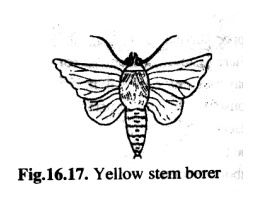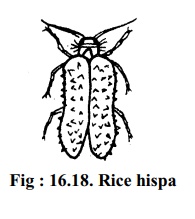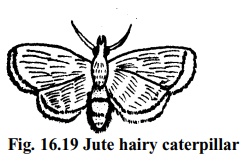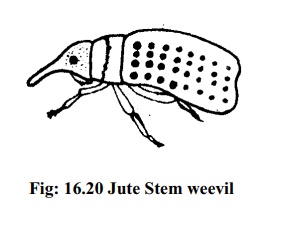Chapter: Biology: Economic Biology
Some harmful insects or pests of paddy and jute
Some harmful insects or pests of paddy and jute
The animals, which cause harmful effect on human comforts, ease and economic profit is called pests. These animals disturb human beings in different ways. Amongst them some insects cause damage to a great extent to the crops in the fields. Of these two of each of the paddy and jute insects, along with their local and scientific names, the amount of their harmful effects and methods of control are discussed here..
Yellow stem borer of paddy: The scientificname of Yellow stem borer is Scirpophagaincertulus; the adult moth is yellow in colour.Female moth lays eggs on paddy. Larvae or caterpillar hatches from egg and comes out by piercing the stem and enters within it. It needs 35-46 days to convert a larva into pupa and 6-10 days are needed to convert the pupa Fig.16.17. Yellow stem borer into adult insects.
Harmful effect: Due to eating of stem the plantdries out and dies.

Control or method of remedy:
a) Biological control: The eggs are to be destroyed by hands.
b) Chemical method: The insect is to be killed by proper insecticides.
2. Rice hispa of paddy: Its scientific name isDicladispa arnigera.They are black in colour and have got spines on the back.

The female insects lay eggs on the leaf of paddy plant. Within 3 days larva comes out which becomes a pupa within 9-12 days, being brown in colour. Pupa becomes adult insect within 3-4 days and lives for 9-12 days.
Harmful effect: Larvae and adult insect eat up thegreen portion of paddy leaf which dries up and becomes white due to the absence of green parts as there is no photosynthesis and these results in the damage of the plant and the production becomes less.
Control or method of Remedy:
Biological control
i. The insect is to be destroyed by light trap.
ii. The effected leaf is to be burnt or buried.
iii. The insects is to be killed by hand.
Chemical control: To kill insect by properinsecticide.
1. Jute hairy caterpillar: Its scientific name is Spilosoma oblique. The female moth lays eggs innumerous numbers on the lower surface of the leaf which develops into larvae in 5-6 days, pupae is developed in 9-10 days from larvae and then the attainment of adult forms.

Harmful effect:
The larvae are like those of caterpillar, which eats the green portion of leaf and sometimes the twig. As a result the plant becomes weak and the production of jute decreases.
2. Stem weevil of jute: Its scientific name is Apion corchori. Adult forms are small andgrey in colour. There is a curved antenna in front of the head. Female insect bores the node of jute plant and lays numerous eggs. The eggs hatch in 3-4 days and then by entering into stem, suck the juice. Pupae are developed within 10-13 days and within 4-5 days adult forms are developed.
Harmful effect:
In the body of the jute plants the knots are developed. During time of rottening of jute, the fibers are torn at the point of the knots. As a result the production becomes decreases.

Remedy or control method:
a) Biological control: By cutting the twigs of jute plant the insects are to be killed.
b) Chemical control: Proper insecticides are to be sprayed in solution with water on jute lands.
The questions in exercise at the end of each chapter of Textbook should be omitted.
Related Topics